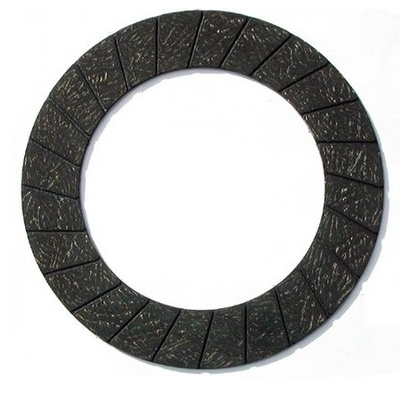Brake pad
Publication Date:
2022-11-21
Brake pads, also known as brake linings, are the most critical safety components in the braking system. The effectiveness of all braking depends decisively on the brake pads, so good brake pads are the protectors of both people and vehicles. Brake pads generally consist of a steel plate, an adhesive heat insulation layer, and a friction block. The heat insulation layer is made of non-heat-conductive materials to provide thermal insulation. The friction block is composed of friction materials and adhesives; during braking, it is pressed against the brake disc or brake drum to generate friction, thereby slowing down the vehicle. Due to friction, the friction block gradually wears out. Generally, lower-cost brake pads wear out faster. Once the friction material is used up, the brake pads must be replaced promptly; otherwise, the steel plate will directly contact the brake disc, ultimately losing braking effectiveness and damaging the brake disc. The torque required to stop or slow down mechanical moving parts is called braking torque. Braking torque is the basis for designing and selecting brakes, and its magnitude is determined by the type and operational requirements of the machinery. The performance of the friction materials (brake components) used on the brake affects the braking process, with the main influencing factors being operating temperature and temperature rise rate. Friction materials should have a high and stable coefficient of friction and good wear resistance. Friction materials are divided into metallic and non-metallic types. Common metallic materials include cast iron, steel, bronze, and powder metallurgy friction materials, while non-metallic materials include leather, rubber, wood, and asbestos.
Brake pads, also known as brake linings, are the most critical safety components in the braking system. The effectiveness of all braking depends decisively on the brake pads, so good brake pads are the protectors of both people and vehicles. Brake pads generally consist of a steel plate, a bonding heat insulation layer, and a friction block. The heat insulation layer is made of non-heat-conductive materials to provide thermal insulation. The friction block is composed of friction materials and adhesives, which are pressed against the brake disc or brake drum during braking to generate friction, thereby slowing down or stopping the vehicle. Due to friction, the friction block gradually wears out. Generally, lower-cost brake pads wear out faster. Once the friction material is used up, the brake pads must be replaced promptly; otherwise, the steel plate will directly contact the brake disc, ultimately losing braking effectiveness and damaging the brake disc. The torque required to stop or slow down mechanical moving parts is called braking torque. Braking torque is the basis for designing and selecting brakes, and its magnitude is determined by the type and operational requirements of the machinery. The performance of the friction materials (braking components) used on the brake affects the braking process, with the main influencing factors being operating temperature and temperature rise rate. Friction materials should have a high and stable coefficient of friction and good wear resistance. Friction materials are divided into metallic and non-metallic types. Common metallic materials include cast iron, steel, bronze, and powder metallurgy friction materials, while non-metallic materials include leather, rubber, wood, and asbestos.
Brake model
YWZ, YWZ3, YWZ4, YWZ5, YWZ8, YWZ10, YWZ9, YWZ13, YWZ series electric hydraulic brakes
ED, YT1, MYT1, YTD series electric hydraulic actuators
JZ, MW, TJ2, ZWZA, ZWZ3 series electromagnetic brakes

QP, CQP series pneumatic caliper disc brakes
DCPZ series electromagnetic caliper disc brakes
YPZ2, YPZ3 series arm disc brakes
SBD, SB series safety brakes
SH, ST series hydraulic fail-safe brakes
DADH series hydraulic direct-acting brakes
SE series electromagnetic fail-safe brakes
SP series pneumatic fail-safe brakes
YFX, YDGZ, YLBZ series windproof brakes
1. Inspection of brakes
For cranes in normal use, the brakes should be inspected every shift. Inspection items include: the integrity of key brake parts, the contact and separation clearance of friction pairs, the reliability of the release mechanism, and the overall working performance of the brake, ensuring sensitivity without sticking.
Before each lifting operation (especially when lifting heavy, large, or precision items), the load should be lifted a short distance off the ground to test and confirm the reliability of the brake performance before proceeding with the operation.
Key points for brake safety inspection are:
(1) The braking friction surface of the brake wheel should have no defects or oil contamination that would impair braking performance;
(2) The wear level of the friction material on the brake band or brake block;
(3) The actual contact area between the brake band or brake block and the brake wheel should not be less than 70% of the theoretical contact area;
(4) The brake should have a heat capacity suitable for the operating frequency, and overheating must not occur;
(5) The control parts of the brake (such as pedals, control handles, etc.) should have anti-slip properties;
(6) For manually controlled brakes, the applied force and travel should not exceed the requirements in Table 6-11. If exceeded, necessary adjustments should be made. Required operating force/movement: generally recommended values - hand control 100 N / 400 mm, foot pedal 120 N / 250 mm; maximum values - hand control 200 N / 600 mm, foot pedal 300 N / 300 mm.
2. Brake scrapping criteria: Brake parts should be scrapped, replaced, or repaired if any of the following conditions occur:
(1) Cracks;
(2) The thickness of the friction lining on the brake band or brake block is worn to 50% of the original thickness;
(3) Springs show plastic deformation;
(4) Wear of the hinge pin or shaft hole diameter reaches 5% of the original diameter;
(5) The brake wheel should be scrapped if any of the following occur:
① Cracks;
② For brake wheels of hoisting and luffing mechanisms, rim thickness wear reaches 40% of the original thickness;
③ For brake wheels of other mechanisms, rim thickness wear reaches 50% of the original thickness;
④ When the wheel surface unevenness reaches 1.5 mm, if repairable, after repair the rim thickness should meet the requirements of items ② and ③ above.
COOKIES
Our website uses cookies and similar technologies to personalize the advertising shown to you and to help you get the best experience on our website. For more information, see our Privacy & Cookie Policy
COOKIES
Our website uses cookies and similar technologies to personalize the advertising shown to you and to help you get the best experience on our website. For more information, see our Privacy & Cookie Policy
These cookies are necessary for basic functions such as payment. Standard cookies cannot be turned off and do not store any of your information.
These cookies collect information, such as how many people are using our site or which pages are popular, to help us improve the customer experience. Turning these cookies off will mean we can't collect information to improve your experience.
These cookies enable the website to provide enhanced functionality and personalization. They may be set by us or by third-party providers whose services we have added to our pages. If you do not allow these cookies, some or all of these services may not function properly.
These cookies help us understand what you are interested in so that we can show you relevant advertising on other websites. Turning these cookies off will mean we are unable to show you any personalized advertising.
Hotline
Address: 240 meters west of the intersection of Tangxin Line and Jianhua Road, Qiantang District, Hangzhou, Zhejiang Province
Email:HRdjmc@hzdjfm.com

Copyright © Hangzhou Dongjiang Friction Materials Co., Ltd. All rights reserved. Powered by www.300.cn | Business Card

